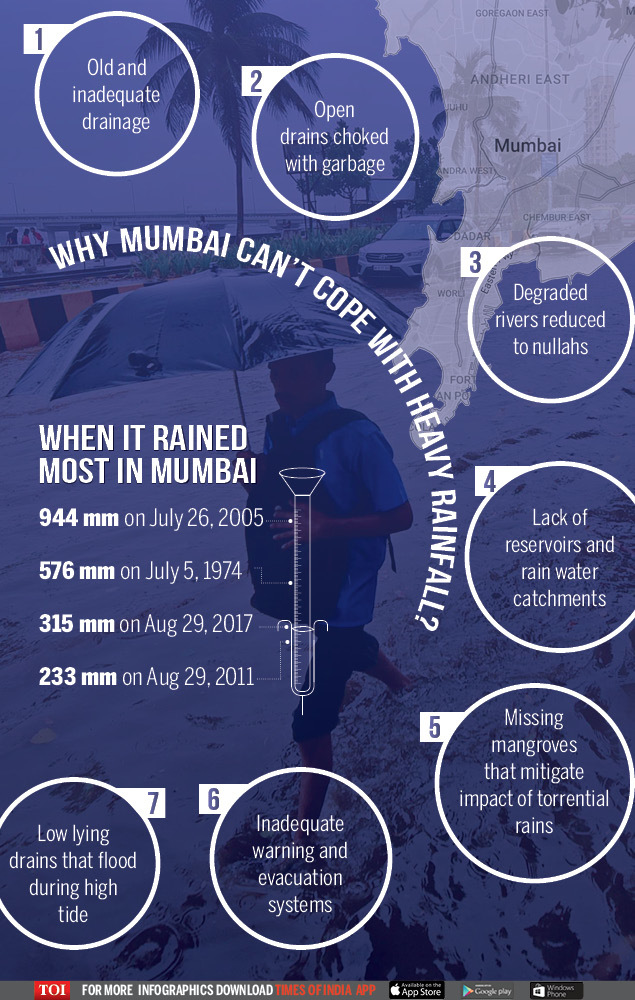Floods in Mumbai
This is a collection of articles archived for the excellence of their content. |
Causes
As in 2018
June 8, 2018: The Times of India
On June 7, 2018, Mumbai received 27.6mm to 37.8mm of rainfall. Certainly not the most, but enough to throw city out of gear with water logging and delayed trains and flights. However, the worst is yet to come. The IMD has forecast heavy rainfall for the city over the weekend. And as per private weather forecaster Skymet, it could be the heaviest since July 26, 2005, when it rained 944mm in just 24 hours, resulting in massive flooding, deaths of over 500 people and losses overs Rs 550 crores.
But heavy rainfall has drowned Mumbai not just once. In fact, the maximum city has experienced monstrous floods twice already in the current decade, in 2011 and 2017. In fact in 2017, insurers had to take a hit of Rs 500 crores in claims.
Being a coastal city, heavy rainfall is a given in Mumbai. Question is why are floods becoming a regular occurrence in the city? One of the biggest reasons is 150-year-old Mumbai’s drainage system. It is designed to handle 2.5 cm (25mm) of rain every hour and that too only if there is no high tide. Two, the desilting and cleaning of drains- an annual exercise by the city’s municipal corporation (BMC) is not carried out properly, despite the fact that BMC is the richest municipal body in Asia with a budget bigger than several states in the country.
Third, the Mithi river, which drains water into Arabian Sea is choking with garbage, silt and sewage, and its floodplains encroached by slums. Though the administration has repeatedly drawn plans to revive the river, they have been abandoned.
Fourth, low-lying areas near deltas and on sinking coasts are crowded with slums making them vulnerable to flooding.
Fifth, heavy rain clubbed with a high tide prevents rain water from flowing into the sea, instead it brings it right back into the city.
Sixth, the depleting mangroves. Mangroves mitigate the impact of torrential rains but cutting them down brings out what is a natural barrier to flooding.
Mithi floods due to 600 acres reclaimed for BKC
Clara Lewis, Sep 8, 2019: The Times of India
A state government agency, the Mumbai Metropolitan Region Development Authority (MMRDA), is the biggest encroacher on the Mithi river, according to a Supreme Court-appointed committee which submitted its report on the river’s status to the apex court in March 2018. The panel has said the reclamation of 600 acres for creation of the Bandra-Kurla Complex (BKC) from 1973 onwards has resulted in the Mithi overflowing and flooding areas around it.
An overflowing Mithi paralysed all three of Mumbai’s suburban railway lifelines on Wednesday and forced evacuation of over 1,000 people from Kranti Nagar and Bamandaya Pada along its banks.
“BKC has been created by carrying out land-filling of 620 acres into the river, wetlands and mangroves. All that area was an integral part of the river estuary (and) has been reclaimed by MMRDA for developing a business hub,” states the committee’s report.
The MMRDA’s steps of controlled blasting of rock to deepen the river mouth, and building retention walls after the 26/7 havoc was challenged by NGOs Jal Biradari and Vanashakti before the National Green Tribunal. The matter went to the Supreme Court, and a verdict is awaited.
An SC-appointed panel including IIT and Neeri experts as well as activists pointed out that land-filling of wetlands & mangroves in the river’s estuary by MMRDA is among the key reasons behind the frequent flooding
